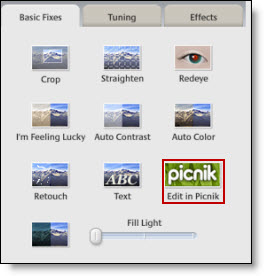On 5 January 2009 Google released a beta version of Picasa for Mac (Intel-based Macs only). Also, a plugin is available for iPhoto to upload to the Picasa Web Albums hosting service. There is also a standalone Picasa Web Albums uploading tools for OS X 10.4 or later. The Picasa for Mac is a Google Labs release.
Since June 2007 Picasa can write geographic coordinates to Exif metadata, thus geotagging an image.
For organizing photos, Picasa has file importing and tracking features, as well as tags, facial recognition, and collections for further sorting. It also offers several basic photo editing functions, including color enhancement, red eye reduction, and cropping. Other features include slide shows, printing, and image timelines. Images can also be prepared for external use, such as for e-mailing or printing, by reducing file size and setting up page layouts. There is also integration with online photo printing services. Other simple editing features include adding text to the image. Picasa supports most RAW files, a user is able to view and edit RAW files and save their finished edit (as JPG, et al) without any changes to the original RAW file.
Users may upload pictures through a variety of ways: via the PWA web interface on supported browsers, Picasa 2.5.0 or later on Microsoft Windows, using the Exporter for iPhoto, the Aperture to Picasa Web Albums plug-in, Uploader on Mac OS X, F-Spot on Linux, or through WAManager in the Amiga-like OS MorphOS. In both free and paid accounts, the actual resolution of the photo is maintained, even though a smaller resolution photo may be displayed by the web interface.
Since version 3.5 of Picasa, Google Earth is not needed. Geotagging may be done directly inside Picasa, using a more practical Google Maps component, which enables this functionality in the Mac OS X version.
Subscribe to:
Post Comments (Atom)



No comments:
Post a Comment